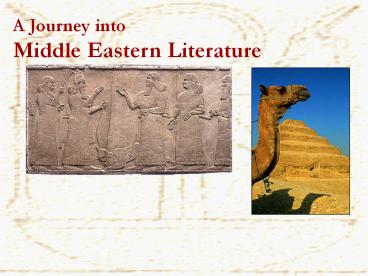A Journey into - PowerPoint PPT Presentation
Title:
A Journey into
Description:
Title: No Slide Title Author: BagamasbadT Last modified by: trainerm Created Date: 11/6/2001 4:49:03 PM Document presentation format: Letter Paper (8.5x11 in) – PowerPoint PPT presentation
Number of Views:52
Avg rating:3.0/5.0
Title: A Journey into
1
A Journey into Middle Eastern Literature
2
THE EPIC OF GILGAMESH
- WHAT?
- Tale of the superhuman Sumerian king, Gilgamesh
- Painful search for everlasting life
- WHEN?
- Written over 4,000 years ago considered the
oldest known piece of literature - Discovered in 1839 by archaeologists
- WHERE?
- Ancient Mesopotamia (Between two rivers -
Tigris and the Euphrates) - current day Iraq - Versions are found all over the Middle East
- HOW?
- Inscribed in clay, which made the text durable
- 12 tablets (1-11 Gilgameshs life 12 Gilgamesh
in the nether world) - Many exact copies were made accuracy was
critical
3
THE EPIC OF GILGAMESHBackground Information
- Gilgamesh
- May be a true story - a King Gilgamesh is found
in the ancient Sumerian records - Two parts god, One part human ? Supernatural
power, Human weaknesses - Leader of the Sumerian people and builder of a
great city - Suffers from excessive PRIDE (what the Greeks
would later call hubris)
4
THE EPIC OF GILGAMESHBackground Information
- Tablets 1 and 2 Gilgamesh and the Coming of
Enkidu - The epic opens with a description of Gilgamesh,
as the ruler of the city-state of Uruk - Gilgamesh is described as handsome, courageous,
and powerful. - In his arrogance, he oversteps the boundaries of
his power ? people pray to the gods for relief - Gods send a wild man, Enkidu, to challenge
Gilgamesh to a fierce wrestling match ? Gilgamesh
wins - A friendship blossoms between Gilgamesh and
Enkidu - Tablets 3 to 5 The Raid into the Lands of
Humbaba - Gilgamesh and Enkidu destroy Humbaba, the demon
who guards the great Cedar Forest - Tablet 6 The Bull of Heaven
- Gilgamesh and Enkidu make the mistake of
criticizing the goddess Ishtar - Gilgamesh rejects Ishtars romantic advances and
she sends the Bull of Heaven to destroy the land - Gilgamesh and Enkidu kill the bull.
5
THE EPIC OF GILGAMESHBackground Information
- Tablets 7 and 8 The Death of Enkidu
- The gods cannot tolerate the disrespect of
Gilgamesh and Enkidu and try to kill Gilgamesh - However, Gilgamesh is protected by Utu (another
god) - The gods decide that Enkidu must die in his place
- Gilgamesh cannot deal with the mortality of the
human race
6
- Tablets 9 and 10 The Search for Immortality
- Gilgamesh journeys to find everlasting life in
the Garden of Dilmun and tells an old, wise man,
Utnapishtim, about his quest. - Utnapishtims reply is not what Gilgamesh wanted
- There is no permanence. Do we build a house
to stand forever, do we seal a contract to hold
for all time? Do brothers divide an inheritance
to keep forever, does the flood time of rivers
endure? From the days of old there is no
permanence. The sleeping and the dead, how alike
they are, they are like painted death. What is
there between master and servant when both have
fulfilled their doom? When the gods created man,
they allotted to him death, but life they
retained in their own keeping.
7
THE EPIC OF GILGAMESHBackground Information
Ancient Sumerian and Babylonian
Beliefs Although Sumerian and Babylonian
civilizations were advanced for their time, the
people were powerless against ever-present
threats of devastating floods, severe droughts,
and belligerent neighbors who sought the good
life in the Tigris and Euphrates valley. The
religious beliefs of the Sumerian and Babylonian
people were, therefore, pessimistic. They
worshipped a pantheon, or family, of
unpredictable gods and goddesses who could bring
about misfortune as well as favor. Regardless of
ones status or how one lived ones life, there
was no joyful afterlife to which to look
forward. Such beliefs are present in The Epic
of Gilgamesh. Gilgamesh, in spite of his great
powers, suffers a life-changing loss when Enkidu
dies. When the person closest to him dies, the
proud Gilgamesh must come to terms with the
reality that he, too, will not live forever. And
because, in the Sumerian view, death offers only
emptiness, Gilgamesh rebels against it, and sets
off on a quest to attain immortality.
8
THE EPIC OF GILGAMESHSIGNIFICANCE
- Why is Gilgameshs story important to us?
- CONCEPTS
- Quest for Knowledge and Truth
- Friendship
- Life and Death
- Birth and Renewal (The Flood)
- Man V. Fate
- LITERARY SIGNIFICANCE
- EPIC
- Definition a long narrative that recounts the
deeds of a larger-than-life hero who embodies
the values of a particular society - EPIC HERO
- Definition Superior human beings with
supernatural strength or spiritual powers
usually mighty leaders of their people of
mixed divine and human birth, so we admire
their greatness but sympathize with their
failings - Gilgamesh is the earliest known epic hero
- Archetype for future epic heroes, including
Homers Odysseus
9
Cuneiform
THE EPIC OF GILGAMESH
- Though the tales of Gilgamesh were originally
shared through oral communication, the epic was
eventually written down using cuneiform. - first form of writing ever developed
- consisted of wedge-shaped characters that were
created using a reed stylus - characters could represent either words or sounds
and were usually carved into clay that was later
baked - http//www.upenn.edu/museum/Games/cuneiform.html
- THE END













![[DOWNLOAD]⚡️PDF✔️ Through Indian eyes: A journey among the Indian tribes of Guiana PowerPoint PPT Presentation](https://s3.amazonaws.com/images.powershow.com/10132898.th0.jpg?_=20240918086)
![[DOWNLOAD]⚡️PDF✔️ Through Indian eyes: A journey among the Indian tribes of Guia PowerPoint PPT Presentation](https://s3.amazonaws.com/images.powershow.com/10136060.th0.jpg?_=202409231112)
![[DOWNLOAD]⚡️PDF✔️ Through Indian eyes: A journey among the Indian tribes of Guia PowerPoint PPT Presentation](https://s3.amazonaws.com/images.powershow.com/10132077.th0.jpg?_=20240917088)















